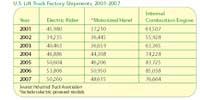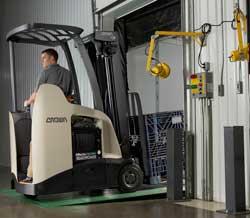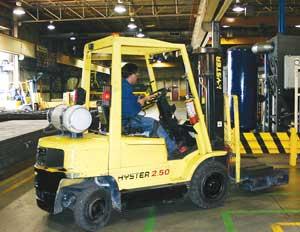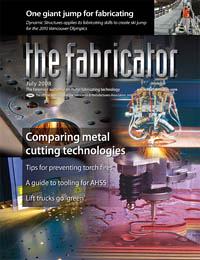Editor-in-Chief
- FMA
- The Fabricator
- FABTECH
- Canadian Metalworking
Categories
- Additive Manufacturing
- Aluminum Welding
- Arc Welding
- Assembly and Joining
- Automation and Robotics
- Bending and Forming
- Consumables
- Cutting and Weld Prep
- Electric Vehicles
- En Español
- Finishing
- Hydroforming
- Laser Cutting
- Laser Welding
- Machining
- Manufacturing Software
- Materials Handling
- Metals/Materials
- Oxyfuel Cutting
- Plasma Cutting
- Power Tools
- Punching and Other Holemaking
- Roll Forming
- Safety
- Sawing
- Shearing
- Shop Management
- Testing and Measuring
- Tube and Pipe Fabrication
- Tube and Pipe Production
- Waterjet Cutting
Industry Directory
Webcasts
Podcasts
FAB 40
Advertise
Subscribe
Account Login
Search
A new look at lift trucks
New environmental regulations lead to new material handling engine technologies
- By Dan Davis
- July 15, 2008
- Article
- Materials Handling
Late-night legend Johnny Carson often played a character called Karnak, who could provide the answer to a question before the question was revealed to him. So in the spirit of this Nebraska-born prognosticator, let's throw out an answer.
A: $4-per-gallon gas.
Q: What caused drivers to ditch their sports-utility vehicles for smaller cars and made a 1998 Chevy Metro® an overnight sensation in collectors' circles?
It's amazing how life in the world of material handling is mimicking the real world in which we—with the exception of Karnak—live. Let's try this again.
A: California environmental regulations.
Q: What is influencing the design of engines for next-generation lift trucks, and what's Ed Begley Jr.'s favorite dinnertime conversation?
That's right. Once again California is on the leading edge of environmental protectionism, and because it is such a large industrial market, the state's environmental regulations are influencing what metal fabricators might be driving in their facilities—no matter what ZIP code they call home.
More specifically, the 2010 standards for controlling smog-causing hydrocarbon and nitrogen oxide emissions set by the California Air Resources Board (CARB) call for a 70 percent reduction in emission allowed by the 2007 standards. EPA has yet to adopt the stricter standards proposed by CARB, but the new emission targets could influence future national regulations. Figure 1shows the large drop in hydrocarbon and nitrogen oxide exhaust emissions targeted for 2010.
In addition to stricter emission levels, CARB also is incorporating measures to reduce emissions from lift truck fleets. Large forklift fleet owners (26 or more trucks), medium fleet owners (4-25 trucks), and small-fleet owners (1-3 trucks) all have to meet various fleet average emission levels starting in 2009 (see Figure 2). These end user fleet averages get more stringent in 2011 and 2013.
"If you look at EPA standards, you'll find that CARB is usually more stringent than the national standards are. But CARB standards are usually indicative of what is to come," said Melinda Beckett-Maines, national marketing manager, Toyota Material Handling U.S.A. "It's a good idea to keep an eye on California to know what's coming for the nation."

Figure 1Click on image to view larger The California Air Resource Board allowed for increased levels of CO so that manufacturers might have an easier time hitting the dramatically lower HC and NOx targets.
Metal fabricators should take note. Tomorrow's alternative motor technologies are almost upon you, and we're not talking about those found in vehicles in your parking lots. These likely will be part of your lift truck mix in the future, whether you like them or not.
A Look at Electric Power
The easiest way to meet new emission standards is to employ lift trucks that don't emit anything. Electric lift trucks fall into this category, and as a result, sales are increasing (see Figure 3).
Electric lift trucks aren't new to industry. In fact, they are the lift truck of choice for applications involving food warehousing or for tightly enclosed indoor spaces.
"There has been a steady change from IC [internal combustion] to electric," said George Marshall, director, sales development, Hyster Co. "There are several reasons for that, but the ability to power a truck in the equivalent way that an IC truck is powered is important. It's become much more possible to get that with an electric truck."
You want power? Marshall said that electric-powered, 12,000-pound models are becoming more commonplace in industrial settings. That puts electric-powered lift trucks in the range metal fabricators often desire. But it doesn't end there. As Marshall said, electric-powered trucks can muster loads as great as 15,000 to 17,000 lbs.
You want speed? Marshall said that electric-powered lift trucks now can reach speeds up to 12 miles per hour, whereas 8 or 9 MPH used to be the top speed.
"Our next-generation trucks that we are producing," he said, "we pretty much match the IC performance in terms of traction speed, which is the biggest measure of productivity. It's more perception than fact, but it is the perceived performance element that the customer is really looking for."
Electric-powered lift trucks are growing in popularity for other reasons as well.
Fast Charging. To get through a full eight-hour shift, electric-powered lift truck operators often had to take additional breaks while their vehicles received a new battery. A switchout was necessary because a battery could require several hours to recharge. Unfortunately, the process to exchange a battery could take almost 20 minutes as employees wrestled with an energy storage device that could weigh as much as 3,500 lbs. With the emergence of fast charging technology, a lift truck can charge quickly over a break, lunch, or in between shifts. The lift truck may not be able to reach a 100 percent charge in the small amount of time it's charging, but it will have enough power to make it until the next charging period. As a result of this technology, many companies are able to run their lift trucks on one battery, forgoing the time and trouble of battery exchanges. The fast charging technology is more expensive than conventional charging systems, but the ability to keep lift trucks up and running is an attractive benefit for many companies.
AC Motors. Simply put, these are motors that operate on alternating current. The motor's outside stationary stator is supplied with AC, which creates a magnetic field. The magnetic field causes the inside rotor to rotate, powering an output shaft. This is a much more efficient motor design when compared to the traditional DC motor design, which requires carbon brushes to pass current to the rotor-mounted windings. The brushes are pressed against the commutator, a set of copper surfaces that are mounted on the rotor, and the brushes eventually wear out and require replacement, something that does not happen with brushless AC motors. Of course, the lift trucks do not require very long cords to attach to an AC outlet; DC batteries store the power, and the lift trucks convert it to AC to power the motor.

Figure 2Click on image to view larger Electric and fuel cell-powered lift trucks are considered zero-emitting sources and could help fleet owners meet the new emission standards in California.
Componentry Protection. Electric-powered lift trucks used to be limited to indoor use. That's changed with the advancement of protective enclosures to keep electronics safe from dust, humidity, rain, and other adverse elements.
Low Noise Levels. There's a reason that many metal fabricating shops require workers to wear earplugs. Usually it's because giant stamping presses are going up and down or a CNC turret punch press is banging away on sheet metal. The constant hum of IC lift trucks doesn't detract from that type of noisy environment. On the other hand, electric-powered lift trucks are much quieter. "All OEMs are chasing that last two hours of a shift where studies say that the dropoff in productivity is as high as 30 to 35 percent," Marshall said. "If you can reduce the fatigue of that person during the last two hours, then his productivity will rise, and the effectiveness of the truck operation and his work will improve."
Overall, the future looks bright for these zero-emission vehicles.
"The nice part is that we are getting power levels that are rivaling IC lift trucks', improved productivity, longer run times, and a lot of other benefits," Toyota's Beckett-Maines said.
The Future: Fuel Cell?
Imagine this scenario. The fuel is hydrogen. The byproduct is water. The charging time for a lift truck is a couple of minutes.
"That's a pretty environmentally friendly truck," said Eric Jensen, manager, new technologies, research and development, Crown Equipment Corp.
It's also a huge opportunity for lift truck manufacturers.
Because as much as electric-powered lift trucks are celebrated for their environmental friendliness, they do require lead acid batteries, which eventually have to be recycled. Of course, lead's not the most welcomed substance in the world.
In a much-reported field trial in 2007, two Ohio Wal-Mart distribution centers completed a four-month-long test of 12 fuel cell-powered lift trucks, some of which were Crown models. The trucks were refueled more than 2,100 times, and refueling took less than 2 minutes per truck. In addition, the hydrogen fueling area took up 200 square feet, compared to the 4,000 sq. ft. needed for the battery-charging and changeout room. Wal-Mart since has invested in fuel cell units to replace lead acid batteries that have been used to power lift trucks at its food distribution center in Washington Court House, Ohio.
"It really makes economic sense for companies to consider fuel cell technology," Jensen said. Figure 4shows a fuel cell-powered lift truck in action.

Figure 3Click on image to view larger Shipments of internal combustion models are expected to decrease as electric-power lift trucks become more powerful and environmental regulations tighten.
Crown is buoyed not only by customer responses in beta testing, but also by support from the public sector. Earlier this year the Ohio Department of Development and Ohio's Third Frontier Commission awarded Crown nearly $1 million to fund fuel cell research. Most of the research will focus on making fuel cell power packs commercially viable for industrial lift trucks.
Jensen said some of the work that still needs to be done includes:
- Finding a way for fuel cell components to mimic the weight of lead acid batteries that the fuel cells likely would be replacing. The batteries act as a ballast in today's electric-powered lift trucks, so the new fuel cell replacement packs will have to weigh the same as the batteries. In the future, new lift trucks designed around a fuel cell power source will be able to resolve the weight issue by distributing the extra weight throughout the vehicle structure.
- Improving the power source's ability to store energy. Small batteries still will be part of the hybrid makeup of the fuel cell power pack, and work needs to be done to maximize the pack's ability to store power.
- Developing fuel cell technology that ensures access to instant power output and smooth ramping up of power.
"I'm starting to see hints that it might be taking off faster than we may have anticipated," Jensen said. "We are near the tipping point."
Internal Combustion: Not Dead Yet
Hold the obituary for IC-powered trucks. Many of them meet current environmental regulatory standards through the use of the latest catalytic converter technology. That's great news for all of the industrial users that want the power and the ability to refuel quickly, whether it's with compressed natural gas, liquid propane, gas, or diesel.
"There are some companies that we deal with that will only want electric lift trucks," said Gearoid Hogan, vice president, marketing, Combilift USA. "But for a majority of our customers that use the lift trucks, both indoor and outdoor, they'll want it to be LP. That may change, but right now we don't see any shift in demand occurring."
That lack of a shift makes sense in that Combilift supplies lift trucks to many heavy industrial sectors. Many of those end users require large lifting capacities, 15,000 lbs. or more. The largest lift truck Combilift manufactures has a 30,000-lb. lifting capacity.
Acknowledging that customers still want IC-powered trucks, Toyota unveiled its 8-Series in 2006 (see Figure 5). The lift trucks were designed not only to meet 2007 national environmental emission standards, but also California's 2010 standards.
The lift truck manufacturer was able to accomplish this by relying on Toyota's 4Y engine. It has a closed-loop fuel system, which is designed to automatically adjust and optimize the air-to-fuel ratio. The lift trucks also have a three-way catalytic muffler to help reduce CO, HC, and NOx emissions.
"I don't see IC trucks disappearing any time soon," Beckett-Maines said.
One Last Answer
A: It's not so hard being green.

Figure 4 For fuel cell-powered lift trucks to be more commercially viable, designers will have to rethink vehicle design to accommodate the fuel cell power packs, which are not as heavy as lead acid batteries.
Q: Where did Kermit the Frog have it wrong?
Lift truck manufacturers will have a plethora of options to choose from to meet stricter environmental standards. It's just a matter of fitting the new lift truck technology to the industrial application.
About the Author

Dan Davis
2135 Point Blvd.
Elgin, IL 60123
815-227-8281
Dan Davis is editor-in-chief of The Fabricator, the industry's most widely circulated metal fabricating magazine, and its sister publications, The Tube & Pipe Journal and The Welder. He has been with the publications since April 2002.
Related Companies
subscribe now

The Fabricator is North America's leading magazine for the metal forming and fabricating industry. The magazine delivers the news, technical articles, and case histories that enable fabricators to do their jobs more efficiently. The Fabricator has served the industry since 1970.
start your free subscription- Stay connected from anywhere

Easily access valuable industry resources now with full access to the digital edition of The Fabricator.

Easily access valuable industry resources now with full access to the digital edition of The Welder.

Easily access valuable industry resources now with full access to the digital edition of The Tube and Pipe Journal.
- Podcasting
- Podcast:
- The Fabricator Podcast
- Published:
- 04/16/2024
- Running Time:
- 63:29
In this episode of The Fabricator Podcast, Caleb Chamberlain, co-founder and CEO of OSH Cut, discusses his company’s...
- Trending Articles
AI, machine learning, and the future of metal fabrication

Employee ownership: The best way to ensure engagement

Steel industry reacts to Nucor’s new weekly published HRC price

Dynamic Metal blossoms with each passing year

Metal fabrication management: A guide for new supervisors

- Industry Events
16th Annual Safety Conference
- April 30 - May 1, 2024
- Elgin,
Pipe and Tube Conference
- May 21 - 22, 2024
- Omaha, NE
World-Class Roll Forming Workshop
- June 5 - 6, 2024
- Louisville, KY
Advanced Laser Application Workshop
- June 25 - 27, 2024
- Novi, MI




























